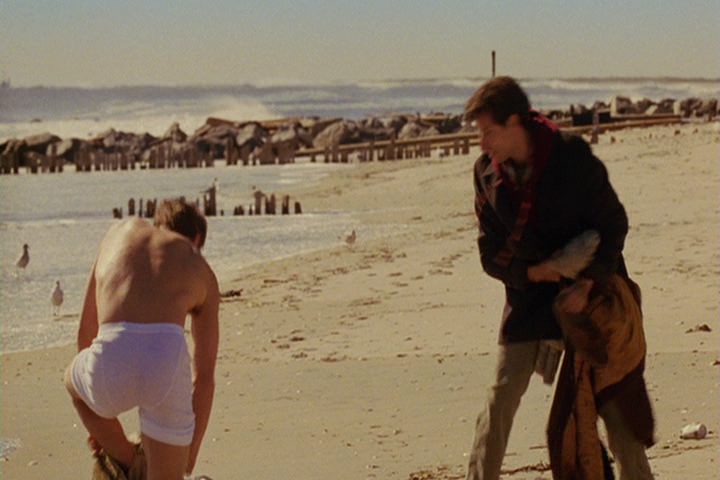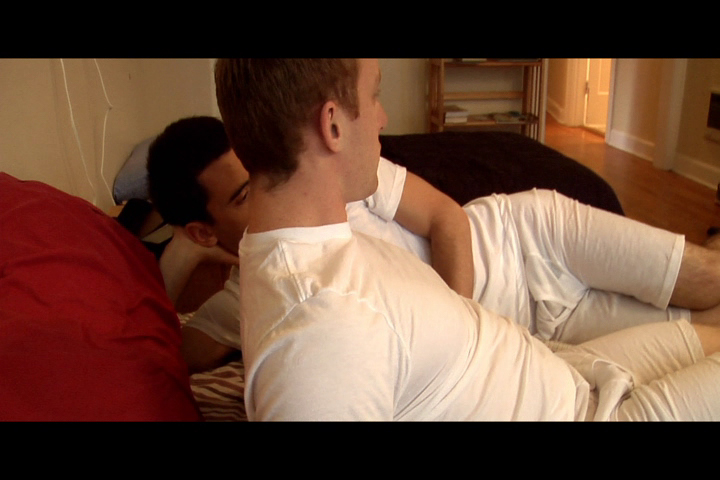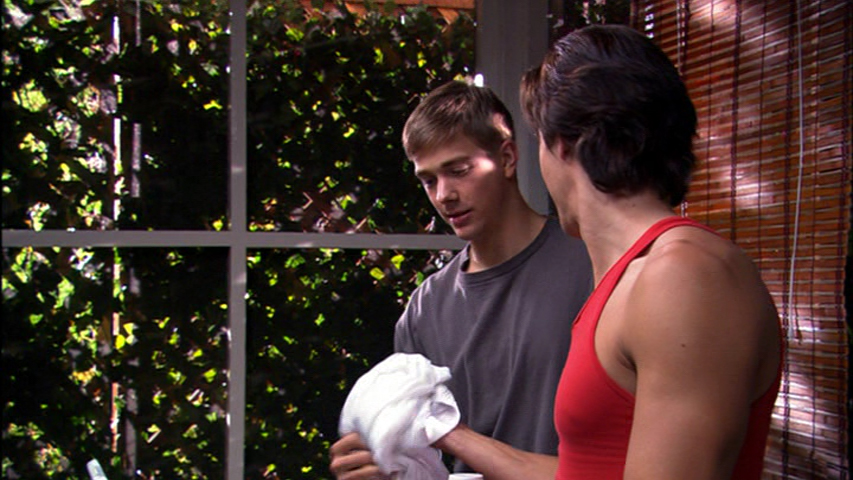
Flaying the Second Skin: Mormon Underwear and Intersectionality
Dai Newman draws attention to movies in which gay Mormon men engage in their first sexual encounter. In each case, the films include a brief moment of exposing sacred Mormon undergarments on the cusp of erotic contact. Newman considers how the garment is a visible, physical marker of conflicting identities and raises questions about the ability of intersectionality theory to explain the overlap of religion and sexuality.
The September before her husband lost the presidential election, Ann Romney set off a minor controversy in Mormon circles for her choice of outfit for an appearance on The Tonight Show with Jay Leno. At issue was not the strangeness of the leather ensemble, but its hemline. Some Mormon viewers immediately jumped to the conclusion that Ann Romney, the most visible Mormon woman in America, was not living up to her religious obligations. The skirt, they claimed, could not possibly cover the underwear that she had covenanted to wear day and night as a temple-endowed Mormon. This was far from the first time the election cycle drew attention to the Romneys’ underthings, with Bill Maher’s vitriolic jabs at “magic underwear” and other late night jokes reminding Mormons of continued suspicion. Outsiders’ sense of Mormon weirdness and secrecy find a powerful emblem in Mormon underwear. While treated mostly as a punchline, a few filmmakers have included moments with Mormons exposing and removing their undergarments not for comedic impact but as a powerful emotional threshold. These moments reverberate beyond Mormonism and raise questions about intersectionality. Central to this theory is the idea that subjects are formed through overlapping axes of difference (gender, race, age, sexuality, socioeconomic status, etc.) in a process that gives rise to complex, multiple identities. The first step towards justice for intersectional theorists is to recognize and reconcile identities in order to make meaningful differences visible. What happens, however, when a subject does not seek to reconcile competing identities?
The undergarments, officially called garments of the holy priesthood, are worn by members of the Church of Jesus Christ of Latter-day Saints after they have taken part in the initiation ritual of washing and anointing. The garments, said to represent the coats of skins God made for Adam and Eve, consists of two pieces and cover from just above the knee to over the shoulders. They are made sacred by the four embroidered marks and can only be purchased directly through the Church. Initiates are instructed to wear them day and night but not to reveal them to anyone who does not understand their significance. In return, wearers are promised safety and protection. Research among garment-wearing Mormons suggests they take seriously the injunction to keep them covered and garments serve as a powerful identity marker [i]. They are a reminder of group affiliation but also one that is to be kept hidden, signaling to the wearer her own commitments rather than broadcasting them. The injunction to not reveal the garments makes Mormons particularly sensitive to their portrayal in film, though the LDS Church has released a video that describes and shows the garments.
 Image 1: Joe Pitt flays himself in Angels in America.
Image 1: Joe Pitt flays himself in Angels in America.
The removal of the undergarments always occurs in relation to a struggle over sexuality. In Angels in America (Mike Nichols, 2003), the closeted, still-married gay Mormon Joe Pitt shows his commitment to his Jewish lover Louis by promising to give up anything to keep him, including his skin. As he strips down to his temple garments, he prepares to take off what he calls his “second skin.” Louis does not understand asking, “how can you stop wearing it if it’s your skin?” Joe does not stall and triumphantly declares “I’m flayed!” In his struggle to be a fully committed gay man, the garments are a hindrance to be cast off. Similarly, Latter Days (C. Jay Cox, 2003) and The Falls (Jon Garcia, 2012) follow missionaries discovering their same-sex desires and exposing their garments to lovers. While garment exposure also occurs with inappropriate heterosexuality in Missionary (Anthony DiBlasi, 2013) and the TV series Quantico [ii], removal of garments is always connected with homosexuality, a sign of the impossibility of being gay and Mormon.
These exposures might appear simply for the erotic thrill of exposing this hidden practice of Mormonism. Indeed, the pornographic website Mormonboyz.com focuses on impossibly sculpted Mormon missionaries engaged in sexual contact in (and out of) their garments. You can also buy your own garments for “sexy role play” through Mormon Secret. I argue, however, that garment removal in non-pornographic films is more than erotic frisson of the forbidden. The garments are visible for only a brief moment, suggesting they are not a striptease to be dwelt upon but a flash to mark a state change. The exposure of the garments in Latter Days, The Falls and Angels in America show the sense that being gay and being Mormon are an unbridgeable chasm. They suggest that a body can either be closed off and protected by religion or open and accessible to same sex contact. These two routes are mutually exclusive.
It might seem like a path out of this problem is intersectional or matrix thinking. Indeed, just as woman has been presumed white or black has been presumed male, we have here a case where Mormon is presumed heterosexual and gay is presumed non-Mormon. Intersectionality would pressure us to reconsider these presumptions. Matrix thinking that rejects either/or should open up for the both Mormon and gay. The garment, however, remains a problematic barrier between single-axis identities and the more lifelike and complicated existence of both/and. Instead of blurring and combining, the garment separates.
Thinking intersectionally, Maria Lugones argues for two kinds of separation and employs metaphors from cooking for both. One is the separation of a pollutant, like the clean separation of yolk from egg white. The other, the marker of impurity, is like when mayonnaise separates: an emulsion that “breaks” and moves from coherent whole to obvious parts. In the case of the gay Mormon the garment is a potent symbol of both these kinds of separation. On the one hand, it is a barrier to keep the body pure and isolated from contact. As Lugones argues, the logic of purity insists on a subject who can stand outside by hiding the ways that subject is constituted. Even though all subjects are formed through “need, emotion, and body,” purity attempts to obscure these three taints from the dominant subject [iii]. Since no such pure subject actually exists, it is imagined by hiding these elements. The garment, as a hidden marker of difference that becomes naturalized for Mormon wearers, is a means of purity separation through occlusion and hiding. The Mormon enters a religious closet every time he puts on the clothes that cover this marker of his identity. The garment stands between the world and the wearer, constraining body, controlling emotion, and structuring needs yet doing so without being seen by others.
 Image 2: RJ and Chris risk breaking surface tension in The Falls.
Image 2: RJ and Chris risk breaking surface tension in The Falls.
On the other hand, the exposure of the garment, right on the cusp of sexual contact shows how the garment serves as a bodily image of an emulsion breaking. The wearer is literally tossing aside his Mormon-ness, the surface tension that has held together his unspoken desires and his religious identity. The “curdled” identity [iv] is, like oil and water, suspended but constantly in danger of separating. While both these identities are in the head as an intellectual proposition, they can coincide. Once these identities are mapped onto the body and enacted in space, the garment is a zone of contestation: keep it on and remain Mormon, take it off and become gay. The mayonnaise separates. Gaymormonnaise spins apart to gay or Mormon, never both. Impurity through mingling and fracturing ensues. Mormon identity and gay identity both rely on action and the body. While we might be prone to assume that mental constructs are cleaner and neater, in this case, simplicity is found in the physicality of wearing or removing the garment while the complexity of both/and can only reside in the mind.

 Image 4: “Colors and whites don’t mix, Aaron.”
Image 4: “Colors and whites don’t mix, Aaron.”
This metaphor works by arguing that Mormonism is white and therefore bland (matching the color of the garments) and austere while active gay sexuality is colorful and therefore lively and exciting (like Christian’s colorful, skimpy and frequently visible underwear). The problem with this logic is that whites and colors can mix, but only at the cost of tinging the whites. This is not an emulsion that holds inseparable parts together in something greater than the parts but an assimilation. It is the garments, the whites, the Mormonism that must give way as a barrier. Living authentically, as gay liberation urges all sexual minorities to do, means at some level a rejection of anything but the brightly colored.
One thing these scenes with garments show is what forms of power and recognition are at stake. Mormon doctrine requires marriage in a temple for the highest level of salvation and eternal progression [v]. Temple marriages are only opposite-sex and any deviation from that path, including the celibacy gay members are enjoined to practice, is viewed as a failure. As someone straddling two groups, the both/and of gay Mormon entails a loss of power when viewed from either axis. Among Mormons, admission of and pursuit of same-sex intimacy is declaring oneself an apostate, a loss of power and privilege with eternal consequences. On the other hand, to admit affiliation with a stridently anti-gay church can often undercut one’s status among other queers. The gay men in these films acutely feel this: as their gay lovers urge them to shrug off Mormonism and their Mormon peers hurl insults at them once their sexuality is discovered. RJ in The Falls asserts his perspective has “changed” since they started having sex. His companion in response defensively calls RJ a faggot. Here Chris wears both pieces of his garments while RJ wears only half, a marker that Chris, the one expelling his own homosexuality, is less removed from the Mormon standard than RJ is.
Gay Mormons are an example of what Lugones calls “thick members”[vi]. Transparent members are those whose needs, interests and instincts seem to line up with the presumed normal vision of the group. Thick members are the messy ends that need to be erased or ignored. The gay Mormon is thick from two angles: he is a thick Mormon because his sexual needs, interests, and instincts run contrary to culture and doctrine but he is also a thick gay man through his continued belief in a homophobic religion. His is a curdled identity trapped between these two. Following Lugones, his is a mestizo consciousness that pressures our understanding of difference. This consciousness is a combination of unmixable identities that creates a new substance, forming new identities with surprising new possibilities. They do not simply add together and exist in a separable state, but whip up into something entirely new. Sometimes these mestizo identities are emulsions and other times they are curdled, but either way, they resist either/or assimilation to one side of the blend. While this route contains possibility, I want to raise a question of it that suggests a way in which religion is different from other markers of identity.
As Vivian May argues in her recent book, intersectionality has become both too present and too empty [vii]. By ignoring the radical, ethical, and political demands of matrix thinking, writers throw in the term intersectional to perform a kind of ornamental diversity. The generally simplistic, poor understanding of intersectionality leads to multiple critiques that May expertly dismantles. I do not wish to repeat the errors of others who have misread the approach to argue that the method presupposes identities as self evident, coherent and separable. Being gay and being Mormon, despite the song from the popular Book of Mormon musical, cannot be thought of as tiny boxes to be crushed or light switches to be turned on and off. Nor do I want to say the problem is that intersectionality fragments ad infinitum and therefore should be shunned as divisive (a replay of single-axis thinking masquerading as intersectional). Rather, I raise the question of how matrix thinking works when the subject with overlapping identities does not actively desire to inhabit both.
In my specific example, I am daring to ask, “What if the Mormon position on sexuality is believed to be right? What can a Mormon who finds himself feeling attraction to the same sex do?” Matrix thinking is very good at highlighting the problem of oppression when lived identities clash with presumptions and power structures. But, inherent and seemingly underexplored in this thinking is the view that the person desires to have these identities recognized, accepted and addressed and anything else is simply giving in to oppression. In the case of a believing gay Mormon, though, he might choose the garments. In each of the films the men made this choice at one point: Joe Pitt is married, Aaron calls his homosexuality “my deepest, darkest secret”, and RJ has brought with him to his mission only his garments and his scriptures (a literalization of the metaphor of baggage). In the films, an outside force (a Jewish lover, a flamboyant gay neighbor, a mission companion) activates a desire that overpowers these previous choices and each ends with the garments off and the men no longer defining themselves as Mormons. These are not men that seek to have both halves recognized. Their stories are viewed mostly as post-liberation indictments of homophobic institutions and fall into a kind of single-axis thinking that places sexuality as the primary and most important recognition one can have.
 Image 5: RJ destroys his garments in The Falls: Another Testament of Love.
Image 5: RJ destroys his garments in The Falls: Another Testament of Love.
Is there no other way? The only other option seen is Chris, the self-hating gay companion in The Falls, who we are not meant to sympathize with when he claims he is “stronger” now and that his intimacies were a mistake, a phase, and a seduction against his will. He opts for Mormonism at the expense of being gay. In either direction, one of these identities is sacrificed. The film prompts us to view Chris as cold and cowardly while RJ is emotional yet brave. The sequel drives this home when RJ finally removes his garments (though carefully ensures appropriate ritual destruction of them) and ends the film “finally free”. But is Chris’s Mormon identity really a less compelling answer to the unbridgeable problem?
Intersectional theorists would almost certainly offer the answer here that we need to bracket my logic as too in line with the status quo, or we should strive for disidentification, or that we should practice active disloyalty. In other words, the claim that being both Mormon and gay is in conflict needs to be changed and results from heterosexist, patriarchal oppression. What these positions show, however, is a presumption that sexuality and its expression trumps religious belief. They might imply that sexuality is not a choice but religion is. They buy into a dominant logic of liberation that can leave little room for questioning. In other words, they bracket a dominant logic for another dominant logic that requires the shift from the Church’s end. Yet, believing Mormons relying on continuing revelation to living prophets and individual members, claim that such a change is not possible. Why does sexuality trump religion? While I do not think we have to accept conservative religious views of sexuality, intersectional theorists could take more seriously religious claims without jumping immediately to viewing these as pure oppression. If a person has an oppressed identity but also sincerely does not desire to have it recognized, is the only option the route of tossing aside oppression and losing along with it powerful communal ties?
I do not actually think that Mormonism cannot change nor do I claim that single-axis thinking is accurate and one has to choose: garment or gayness, sainthood or sex. But, following Lugones, I agree that our identities are curdled into emulsions that may require more stirring for some than others to maintain. The current landscape requires much more stirring from gay religious believers. What cost are we asking believers with non-normative sexualities to bear? To constantly guard against breaking and remain curdled requires great effort. But to urge the loss of religious commitments or sexual expression are not welcoming alternatives. Intersectionality does hold promise for eventually decreasing the amount of labor required just to stay coherent by forcing us to understand and interact with each other as more complex subjects. But until the revelation comes and the religious boundaries shifts, the costs are immense and perhaps we are only adding to the burden by arguing that the right answer is always and forever either flaying oneself, casting off garments and oppression, or bending religious belief, scumbling lines to make room for both.
Notes
- i. McDannell, Colleen. Material Christianity: Religion and Popular Culture in America (New Haven: Yale University, 1998): 198-220.
- ii. It is telling that the characters in Quantico and Missionary are shown getting dressed. In covering up their garments, they trace a long line in the history of portraying Mormon devotion as an alibi for sexual deviance.
- iii. Lugones, Maria. “Purity, Impurity and Separation,” Signs 19 (1994): 467.
- iv. Ibid., 470.
- v. Doctrine and Covenants 132: 4, 17-21. Marriage is one of Mormonism’s “saving ordinances” that all people must perform (or have performed for them vicariously) to achieve total salvation, the others include baptism, confirmation, ordination to the priesthood (for men), and temple endowments.
- vi. Lugones, 474.
- vii. May, Vivian. Pursuing Intersectionality, Unsettling Dominant Imaginaries. (New York: Routledge, 2015)
